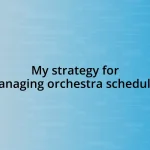Key takeaways:
- Effective orchestral conducting relies on communication, empathy, and adaptability, creating a cohesive and dynamic musical experience.
- Building rapport with musicians through personal connections and trust fosters a collaborative environment, enhancing performance quality.
- Utilizing effective rehearsal strategies such as breathing exercises and targeted sectionals can significantly improve group dynamics and individual confidence.
- Applying conductors’ lessons in personal practice, like routine check-ins and focusing on individual skill development, can enrich musical growth and performance.

Understanding orchestral conducting
Orchestral conducting is much more than just waving a baton; it’s about connection and communication. I remember the first time I watched a conductor lead an orchestra—a stunning blend of passion and precision that left me in awe. The way they elicited dynamics and emotion from the musicians made me wonder, how do they create that magic?
When I think about what it means to understand orchestral conducting, I often reflect on the idea of creating a shared vision among diverse musicians. A while ago, I attended a rehearsal where the conductor transformed a chaotic scene into something cohesive through simple gestures and eye contact. It struck me how vital this trust and synergy are—the flutist and cellist seemed to speak a language all their own, guided by the conductor’s energy. Isn’t it fascinating how non-verbal cues can inspire such harmony?
Ultimately, effective conducting hinges on the balance of leadership and empathy. I’ve seen conductors who are technically brilliant yet fail to connect emotionally with the players, and the result can be lackluster performances. This makes me think, how can a conductor truly interpret a score without genuinely understanding the musicians behind the notes?

Insights from famous conductors
Throughout my journey exploring the world of orchestral conductors, I’ve been particularly struck by the lessons drawn from some legendary figures. For instance, Leonard Bernstein often emphasized the importance of storytelling in music. His approach revealed how crucial it is for a conductor to embody the narrative of a piece, drawing both the musicians and the audience into a shared experience. I still vividly recall a masterclass where he described each orchestral phrase as a chapter in a novel. His passion transformed the way I perceive conducting: it’s not just about the notes, but about holding an audience’s heart.
Consider these insights from great conductors and what they teach us:
- Communication is Key: Effective conductors articulate their vision clearly, ensuring that every musician understands their role.
- Empathy Connects: Maestro Claudio Abbado always made effort to know the personal stories of each musician, fostering a genuine bond that improved performance.
- Adaptability Matters: Daniel Barenboim demonstrated flexibility in interpretations, showcasing how adapting to the musicians’ strengths can elevate the overall sound.
- Engagement and Energy: Herbert von Karajan’s palpable energy inspired performers to match his intensity, creating electrifying performances that resonated with audiences.
These insights illustrate that conducting is a multifaceted dance of understanding, connection, and vision—elements that can transform a musical experience from ordinary to extraordinary.

Key skills of successful conductors
Conductors harness an array of key skills that elevate orchestral performances. One of the most critical is communication. I recall a rehearsal where the conductor used subtle changes in his posture and gestures to convey tempo shifts without saying a word. It was a powerful reminder that sometimes, the subtlest forms of expression can lead to the most profound results.
Another essential skill is adaptability. I’ve seen a conductor switch interpretations mid-rehearsal based on the players’ responses, creating a dynamic dialogue that sparked creativity. This ability to pivot not only enhances the performance but also fosters a sense of collaboration within the orchestra—an experience that I believe every conductor should embrace.
Finally, empathy stands out as a cornerstone of effective conducting. I remember how a well-known conductor would spend time before rehearsals checking in with the musicians. By acknowledging their individual experiences and emotions, he created an environment of trust. This connection translated directly into the performances, where the orchestra played not just as individuals but as a unified entity. Isn’t it inspiring how such skills can transform music into a shared journey?
| Key Skill | Description |
|---|---|
| Communication | Using clear verbal and non-verbal cues to convey vision and expectations. |
| Adaptability | Adjusting interpretations in response to the orchestra’s dynamics and strengths. |
| Empathy | Building genuine connections with musicians to enhance trust and collaboration. |

Building a rapport with musicians
Building a rapport with musicians is vital for an effective conductor. I remember attending a rehearsal where the conductor casually sat down with the string section before starting, joking about the last concert’s mishaps. This simple act lightened the mood and made each player feel valued, setting a collaborative tone for the session. It’s these moments of relatability that can break down barriers and create a supportive environment.
One time, I witnessed a conductor who took the time to learn the names and even a few hobbies of the orchestra members. During breaks, he would casually ask about their week, which made a noticeable difference in how the musicians engaged during rehearsals. It’s fascinating how a little personal attention can transform the dynamics of a rehearsal space. When musicians feel they are acknowledged as individuals, rather than just parts of a larger machine, their performances often become more passionate and connected.
Trust is another key element in building rapport. I distinctly remember a conductor openly admitting his uncertainty about certain sections of a complex piece, encouraging the musicians to share their perspectives. This vulnerability fostered an atmosphere of openness, where everyone felt empowered to contribute. It raises the question: how often do leaders open themselves up to their teams? When conductors show vulnerability, they create a safe space for creativity to flourish, which is essential for a memorable performance.

Effective rehearsal strategies
During rehearsals, pacing can profoundly affect progress. I once experienced a conductor who dedicated the first ten minutes solely to breathing exercises, helping the entire orchestra center themselves before diving into the music. This practice not only calmed nerves but also fostered a shared focus that transformed our dynamic. Have you ever noticed how just a few minutes of intentional grounding can shift the energy in a group? It’s impressive what a mindful start can achieve.
Another effective strategy I’ve observed is the use of targeted sectionals. I recall a situation where the conductor decided to break the orchestra into smaller groups for a challenging piece. This approach allowed musicians to dive deeply into their specific parts without the pressure of the full ensemble. Afterwards, when we reconvened, it felt like each player had grown in confidence, and the synergy was palpable. Isn’t it interesting how focusing individually can fortify the collective sound?
Lastly, by focusing on specific musical elements, conductors can ensure everyone is aligned. I remember a rehearsal where we worked meticulously on articulation – the way notes are played or sung – and the impact was immediate. The conductor utilized playful examples to clarify his vision, and soon enough, the entire piece came alive with character. This experience reminded me how pinpointing details, rather than rushing through the score, can bring a beautiful depth to the performance. Wouldn’t you agree that attention to detail makes a world of difference?

Applying lessons in personal practice
Applying lessons from orchestral conductors in personal practice can deeply enrich our journey. I remember when I decided to adopt the conductor’s approach of routine check-ins with my own practice sessions. Rather than just plowing through scales, I would take a moment at the beginning to reflect on my mindset and intentions. This simple shift made a remarkable difference; I found myself more present and connected to the music I was playing. Have you ever felt that a few intentional breaths can align your focus significantly?
Another eye-opening lesson I applied was the emphasis on individual skill development before returning to the ensemble. Inspired by conductors who break down complex pieces into manageable sections, I began isolating challenging passages in my practice. Instead of getting overwhelmed by the entire piece, I approached it bit by bit. The satisfaction of mastering a tricky segment, however small, reminded me of the joy of progress – it’s almost like discovering hidden gems in familiar territory, don’t you think?
Incorporating feedback has been transformative as well. Similar to a conductor who thrives on input from musicians, I started seeking more outside perspectives on my playing. Whether it’s asking a friend or recording myself to hear what others might catch, this openness has deepened my growth. Engaging with varied viewpoints adds layers to my interpretation and ultimately enhances my performance. How can we ever truly improve without regularly checking in with others?















